Impact of Climate Change on Paddy Farming in the Village Tank Cascade Systems of Sri Lanka
Abstract
1. Introduction
2. Materials and Methods
2.1. Study Area
2.2. Analysis of Observed Climate Data
2.3. Assessment of Long-Term Projected Climate Data
2.4. Modelling Future Climate Suitability Areas
2.4.1. Extraction of Paddy Cultivation Location Data
2.4.2. Selection of Environmental Variables
2.4.3. MaxEnt Modelling
2.4.4. Area Suitability Mapping and Change Dynamics
3. Results
3.1. Changes in Observed Climate
3.1.1. Changes in Variability and Trends of Temperature and Rainfall
3.1.2. Anomalies of Probability Distribution of Temperature and Rainfall
3.2. Changes in Future Climate
3.3. Changes in Future Climate Suitability Areas
Spatio-Temporal Dynamics of Climate Suitability
4. Discussion
4.1. Climate Variability and Trend
4.2. Anomalies of Probability Distribution of Temperature and Rainfall
4.3. Changes in Climate Suitability
5. Conclusions
Author Contributions
Funding
Institutional Review Board Statement
Informed Consent Statement
Data Availability Statement
Acknowledgments
Conflicts of Interest
References
- Wheeler, T.; Von Braun, J. Climate change impacts on global food security. Science 2013, 341, 508–513. [Google Scholar] [CrossRef]
- Zhang, Z.; Li, Y.; Xinguo, C.; Wang, Y.; Niu, B.; Li Liu, D.; He, J.; Pulatov, B.; Hassan, I.; Meng, Q. Impact of climate change and planting date shifts on growth and yields of double cropping rice in southeastern China in future. Agric. Syst. 2023, 205, 103581. [Google Scholar] [CrossRef]
- IPCC. Summary for Policymakers. In Climate Change 2022: Impacts, Adaptation and Vulnerability. Contribution of Working Group II to the Sixth Assessment Report of the Intergovernmental Panel on Climate Change; Pörtner, H.-O., Roberts, D.C., Tignor, M., Poloczanska, E.S., Mintenbeck, K., Alegría, A., Craig, M., Langsdorf, S., Löschke, S., Möller, V., et al., Eds.; Cambridge University Press: Cambridge, UK; New York, NY, USA, 2022; pp. 3–33. [Google Scholar]
- Ricciardi, V.; Ramankutty, N.; Mehrabi, Z.; Jarvis, L.; Chookolingo, B. How much of the world’s food do smallholders produce? Glob. Food Secur. 2018, 17, 64–72. [Google Scholar] [CrossRef]
- Hlophe-Ginindza, S.N.; Mpandeli, N. The Role of Small-Scale Farmers in Ensuring Food Security in Africa. In Food Security in Africa; Barakat, M., Ed.; IntechOpen: London, UK, 2020; p. 11. [Google Scholar]
- Fanzo, J. From big to small: The significance of smallholder farms in the global food system. Lancet Planet. Health 2017, 1, e15–e16. [Google Scholar] [CrossRef]
- IPCC. Summary for Policymakers. In Climate Change and Land: An IPCC Special Report On Climate Change, Desertification, Land Degradation, Sustainable Land Management, Food Security, and Greenhouse Gas Fluxes in Terrestrial Ecosystems; Shukla, P.R., Skea, J., Buendia, E.C., Masson-Delmotte, V., Pörtner, H.-O., Roberts, D.C., Zhai, P., Slade, R., Connors, S., Diemen, R.V., et al., Eds.; Cambridge University Press: Cambridge, UK; New York, NY, USA, 2019; pp. 3–36. [Google Scholar]
- FAO. “Globally Important Agricultural Heritage Systems” (GIAHS). Available online: https://www.fao.org/giahs/giahsaroundtheworld/designated-sites/asia-and-the-pacific/the-cascaded-tank-village-system-ctvs-in-the-dry-zone-of-sri-lanka/detailed-information/en/ (accessed on 26 January 2021).
- Weerahewa, J.; Timsina, J.; Wickramasinghe, C.; Mimasha, S.; Dayananda, D.; Puspakumara, G. Ancient irrigation systems in Asia and Africa: Typologies, degradation and ecosystem services. Agric. Syst. 2023, 205, 103580. [Google Scholar] [CrossRef]
- Ratnayake, S.S.; Khan, A.; Reid, M.; Dharmasena, P.B.; Hunter, D.; Kumar, L.; Herath, K.; Kogo, B.; Kadupitiya, H.K.; Dammalage, T.; et al. Land Use-Based Participatory Assessment of Ecosystem Services for Ecological Restoration in Village Tank Cascade Systems of Sri Lanka. Sustainability 2022, 14, 10180. [Google Scholar] [CrossRef]
- Dharmasena, P. Cascaded Tank-Village System: Present status and prospects. In Agricultural Research for Sustainable Food Systems in Sri Lanka; Marambe, B., Weerahewa, J., Dandeniya, W.S., Eds.; Springer: Singapore, 2020; pp. 63–75. [Google Scholar]
- Sebastian, M.K.; Azeez, P. Ecological and Ethno-Cultural Examination of the Rise and Fall of Rice Culture in Southern India with Special Reference to the Western Ghats; Sálim Ali Centre for Ornithology and Natural History: Coimbatore, India, 2014; p. 159. [Google Scholar]
- FAO. Globally Important Agricultural Heritage Systems: Combining Agricultural Biodiversity, Resilient Ecosystems, Traditional Farming Practices and Cultural Identity; FAO: Rome, Italy, 2018; Available online: https://www.fao.org/documents/card/en/c/I9187EN (accessed on 26 January 2021).
- Dayananda, D.; Weerahewa, J.; Weerasooriya, S. Water availability, crop choices and profitability of farming: A case study of Mahakanumulla tank village. Trop. Agric. Res. 2021, 32, 81–94. [Google Scholar] [CrossRef]
- Sirimanna, S.; Prasada, D. Water productivity in tank cascade systems: A case study in Mahakanumulla tank cascade, Sri Lanka. Trop. Agric. Res. 2021, 32, 298–306. [Google Scholar] [CrossRef]
- Gunawardena, E. Proposed Research Areas Considering the Present-Day Challenges Associated with Minor Tanks/Tank Cascades. In Proceedings of the Cascade Ecology and Management, Peradeniya, Sri Lanka, 17–18 September 2021; Weerasooriya, S.A., Dayananda, M.D.T., Rajapaksha, R.W.W.K.A.D., Silva, P.S.H., Nayanathara, U.W.N.N., Wickramasinghe, M.R.C.P., Kulasinghe, H.P.G.T.N., Eds.; Faculty of Agriculture, University of Peradeniya: Peradeniya, Sri Lanka, 2021; pp. 16–17. [Google Scholar]
- IPCC. Climate Change 2014: Impacts, Adaptation, and Vulnerability. Part B: Regional Aspects. Contribution of Working Group II to the Fifth Assessment Report of the Intergovernmental Panel on Climate Change. In AR5-Fifth Assessment Report of the Intergovernmental Panel on Climate Change; Barros, V.R., Field, C.B., Dokken, D.J., Mastrandrea, M.D., Mach, K.J., Bilir, T.E., Chatterjee, M., Ebi, K.L., Estrada, Y.O., Genova, R.C., et al., Eds.; Cambridge University Press: Cambridge, UK; New York, NY, USA, 2014; p. 688. [Google Scholar]
- Lobell, D.B.; Gourdji, S.M. The influence of climate change on global crop productivity. Plant Physiol. 2012, 160, 1686–1697. [Google Scholar] [CrossRef]
- Lobell, D.B.; Burke, M.B.; Tebaldi, C.; Mastrandrea, M.D.; Falcon, W.P.; Naylor, R.L. Prioritizing climate change adaptation needs for food security in 2030. Science 2008, 319, 607–610. [Google Scholar] [CrossRef]
- APN. Climate Smart Agriculture through Sustainable Water Use Management: Exploring New Approaches and Devising Strategies for Climate Change Adaptation in South Asia; Asia-Pacific Network for Global Change Research: Kobe, Japan, 2018; p. 65. [Google Scholar]
- WFP. Sri Lanka food Security Atlas: Livelihoods, Food Security and Resilience; World Food Programme: Colombo, Sri Lanka, 2015; p. 27. [Google Scholar]
- Kariyawasam, C.S.; Kumar, L.; Kogo, B.K.; Ratnayake, S.S. Long-term changes of aquatic invasive plants and implications for future distribution: A case study using a tank cascade system in Sri Lanka. Climate 2021, 9, 31. [Google Scholar] [CrossRef]
- Ratnayake, R.S.S.; Kumar, L.; Dharmasena, P.B.; Kadupitiya, H.K.; Kariyawasam, C.S.; Hunter, D. Sustainability of village tank cascade systems of Sri Lanka: Exploring cascade anatomy and socio-ecological nexus for ecological restoration planning. Challenges 2021, 12, 24. [Google Scholar] [CrossRef]
- Wickramasinghe, M.R.C.P.; Dayawansa, N.D.K.; Jayasiri, M.M.J.G.C.N.; Silva, R.P.D. A study on external pressures of an ancient irrigation cascade system in Sri Lanka. Agric. Syst. 2023, 205, 13. [Google Scholar] [CrossRef]
- Jayawardena, I.S.P.; Darshika, D.T.; Herath, H.R.C. Recent trends in climate extreme indices over Sri Lanka. Am. J. Clim. Chang. 2018, 7, 586–599. [Google Scholar] [CrossRef]
- MOE. National Adaptation Plan for Climate Change Impacts in Sri Lanka: 2016–2025; Climate Change Secretariat, Ministry of Mahaweli Development and Environment: Colombo, Sri Lanka, 2016.
- Eriyagama, N.; Smakhtin, V. Observed and Projected Climatic Changes, Their Impacts and Adaptation Options for Sri Lanka: A Review. In Proceedings of the National Conference on Water, Food Security and Climate Change in Sri Lanka, BMICH, Colombo, Sri Lanka, 9–11 June 2009; Evans, A., Jinapala, K., Eds.; International Water Management Institute (IWMI): Colombo, Sri Lanka, 2010; p. 186. [Google Scholar]
- IOB. Adapting to Climate Change: A Sri Lankan Perspective; Institute of Biology Sri Lanka (IOBSL): Colombo, Sri Lanka, 2020; p. 198. [Google Scholar]
- Eriyagama, N.; Smakhtin, V.; Chandrapala, L.; Fernando, K. Impacts of Climate Change on Water Resources and Agriculture In Sri Lanka: A Review and Preliminary Vulnerability Mapping: IWMI Research Report 135; International Water Management Institute (IWMI): Colombo, Sri Lanka, 2010; p. 51. [Google Scholar]
- Dharmasena, P.B. Soil Erodibility and Rainfall Erosivity in the Dry Zone of Sri Lanka: Chapter 5 of the Ph.D. Thesis ‘Soil Erosion Control Measures for Rain-Fed Farming in the Dry Zone of Sri Lanka’. Ph.D. Thesis, University of Peradeniya, Peradeniya, Sri Lanka, 1992. [Google Scholar]
- Menike, A.R.M.M.P.; Hemachandra, E.M.G.P.; Dayawansa, N.D.K.; Galagedara, L.W.; Mowjood, M.I.M. Assessment of The Mitigation Capacity of Village Tank Cascade System (VTCS) on Climatic Extremes (Flood and Drought) Using Standard Precipitation Index (SPI). In Proceedings of the Cascade Ecology and Management (CEM), Peradeniya, Sri Lanka, 17–18 September 2021; Weerasooriya, S.A., Dayananda, M.T.D., Rajapaksha, A.D., Silva, P.S.H., Nayanathara, U.W.N.N., Wickramasinghe, M.R.C.P., Kulasinghe, G.T.N., Eds.; Faculty of Agriculture, University of Peradeniya: Peradeniya, Sri Lanka, 2021; pp. 47–49. [Google Scholar]
- Wickramasinghe, M.R.C.P.; Dayawansa, N.D.K.; De Silva, R.P.; Jayasiri, M.M.J.G.C.N. Impact of Human Interventions On The Ancient Village Tank Cascade Systems: A Case Study of Mahakanumulla Cascade System in Sri Lanka. In Proceedings of the Cascade Ecology and Management (CEM), University of Peradeniya, Peradeniya, Sri Lanka, 17–18 September 2021; Weerasooriya, S.A., Dayananda, M.T.D., Rajapaksha, A.D., Silva, P.S.H., Nayanathara, U.W.N.N., Wickramasinghe, M.R.C.P., Kulasinghe, G.T.N., Eds.; Faculty of Agriculture, University of Peradeniya: Peradeniya, Sri Lanka, 2021; pp. 50–53. [Google Scholar]
- De Silva, C.S. Impact of Climate Change on Water Resources and Agriculture in Sri Lanka. In Proceedings of the International Conference on Climate Change Impacts and Adaptations for Food and Environment Security on Sustaining Agriculture Under Changing Climate, Lunuwila, Sri Lanka, 30–31 July 2013; Gunasena, H.P.M., Gunathilake, H.A.J., Everard, J.M.D.T., Ranasinghe, C.S., Nainanayake, A.D., Eds.; Coconut Research Institute: Lunuwila, Sri Lanka; Ministry of Environment and Renewable Energy, Sri Lanka and World Agroforestry Center Regional Office: New Delhi, India, 2013; pp. 67–72. [Google Scholar]
- Muthuwatta, L.; Perera, H.; Eriyagama, N.; Upamali Surangika, K.; Premachandra, W. Trend and variability of rainfall in two river basins in Sri Lanka: An analysis of meteorological data and farmers’ perceptions. Water Int. 2017, 42, 981–999. [Google Scholar] [CrossRef]
- Leaker, A. An investigation of the factors affecting paddy yields from two districts of Sri Lanka. J. Natn. Sci. Coun. Sri Lanka 1984, 12, 71–92. [Google Scholar]
- De Silva, C.S.; Weatherhead, E.K.; Knox, J.W.; Rodriguez-Diaz, J.A. Predicting the impacts of climate change: A case study of paddy irrigation water requirements in Sri Lanka. Agric. Water Manage. 2007, 93, 19–29. [Google Scholar] [CrossRef]
- Hatfield, J.L.; Antle, J.; Garrett, K.A.; Izaurralde, R.C.; Mader, T.; Marshall, E.; Nearing, M.; Philip Robertson, G.; Ziska, L. Indicators of climate change in agricultural systems. Clim. Chang. 2020, 163, 1719–1732. [Google Scholar] [CrossRef]
- Hannah, L.; Roehrdanz, P.R.; K.C., K.B.; Fraser, E.D.; Donatti, C.I.; Saenz, L.; Wright, T.M.; Hijmans, R.J.; Mulligan, M.; Berg, A. The environmental consequences of climate-driven agricultural frontiers. PLoS ONE 2020, 15, e0228305. [Google Scholar]
- Zaveri, E.; Russ, J.; Damania, R. Rainfall anomalies are a significant driver of cropland expansion. Proc. Natl. Acad. Sci. USA 2020, 117, 10225–10233. [Google Scholar] [CrossRef]
- Dang, A.T.; Kumar, L.; Reid, M. Modelling the potential impacts of climate change on rice cultivation in Mekong Delta, Vietnam. Sustainability 2020, 12, 9608. [Google Scholar] [CrossRef]
- Jayawardena, S.; Darshika, T.; Herath, R. Observed Climate Trends, Future Climate Change Projections and Possible Impacts for Sri Lanka. In NeelaHaritha-Climate Change Magazine of Sri Lanka; The Climate Change Secretariat, Ministry of Mahaweli Development and Environment: Battaramulla, Sri Lanka, 2017; pp. 144–151. Available online: http://www.climatechange.lk/Publications_2016/NeelaHarithaMagazine_2017.pdf (accessed on 10 January 2021).
- Annisa, H.; Nugroho, B. Analysis and projections of rainfall using Representative Concentration Pathways (RCPs) scenarios in Sleman Yogyakarta. IOP Conf. Ser. Earth Environ. Sci. 2021, 653, 012099. [Google Scholar] [CrossRef]
- Okkan, U.; Kirdemir, U. Downscaling of monthly precipitation using CMIP5 climate models operated under RCPs. Meteorol. Appl. 2016, 23, 514–528. [Google Scholar] [CrossRef]
- Zhang, Y.; Wang, Y.; Niu, H. Spatio-temporal variations in the areas suitable for the cultivation of rice and maize in China under future climate scenarios. Sci. Total Environ. 2017, 601, 518–531. [Google Scholar] [CrossRef]
- Tangang, F.; Juneng, L.; Cruz, F.; Chung, J.X.; Ngai, S.T.; Salimun, E.; Mohd, M.S.F.; Santisirisomboon, J.; Singhruck, P.; PhanVan, T. Multi-model projections of precipitation extremes in Southeast Asia based on CORDEX-Southeast Asia simulations. Environ. Res. 2020, 184, 109350. [Google Scholar]
- Singh, K.; McClean, C.J.; Büker, P.; Hartley, S.E.; Hill, J.K. Mapping regional risks from climate change for rainfed rice cultivation in India. Agric. Syst. 2017, 156, 76–84. [Google Scholar] [CrossRef]
- Beck, J. Predicting climate change effects on agriculture from ecological niche modeling: Who profits, who loses? Clim. Chang. 2013, 116, 177–189. [Google Scholar] [CrossRef]
- Kogo, B.K.; Kumar, L.; Koech, R. Climate change and variability in Kenya: A review of impacts on agriculture and food security. Environ. Dev. Sustain. 2021, 23, 23–43. [Google Scholar] [CrossRef]
- Chhogyel, N.; Kumar, L.; Bajgai, Y.; Jayasinghe, L.S. Prediction of Bhutan’s ecological distribution of rice (Oryza sativa L.) under the impact of climate change through maximum entropy modelling. J. Agric. Sci. 2020, 158, 25–37. [Google Scholar] [CrossRef]
- Su, P.; Zhang, A.; Wang, R.; Wang, J.A.; Gao, Y.; Liu, F. Prediction of future natural suitable areas for rice under Representative Concentration Pathways (RCPs). Sustainability 2021, 13, 1580. [Google Scholar] [CrossRef]
- Heumann, B.W.; Walsh, S.J.; McDaniel, P.M. Assessing the application of a geographic presence-only model for land suitability mapping. Ecol. Inform. 2011, 6, 257–269. [Google Scholar] [CrossRef]
- Castro-Llanos, F.; Hyman, G.; Rubiano, J.; Ramirez-Villegas, J.; Achicanoy, H. Climate change favors rice production at higher elevations in Colombia. Mitig. Adapt. Strateg. Glob. Chang. 2019, 24, 1401–1430. [Google Scholar] [CrossRef]
- Akpoti, K.; Kabo-Bah, A.T.; Dossou-Yovo, E.R.; Groen, T.A.; Zwart, S.J. Mapping suitability for rice production in inland valley landscapes in Benin and Togo using environmental niche modeling. Sci. Total Environ. 2020, 709, 136165. [Google Scholar] [CrossRef]
- Liu, Z.; Yang, P.; Tang, H.; Wu, W.; Zhang, L.; Yu, Q.; Li, Z. Shifts in the extent and location of rice cropping areas match the climate change pattern in China during 1980–2010. Reg. Environ. Chang. 2015, 15, 919–929. [Google Scholar] [CrossRef]
- Elith, J.; Graham, C.H.; Anderson, R.P.; Dudík, M.; Ferrier, S.; Guisan, A.; Hijmans, R.J.; Huettmann, F.; Leathwick, J.R.; Lehmann, A. Novel methods improve prediction of species’ distributions from occurrence data. Ecography 2006, 29, 129–151. [Google Scholar] [CrossRef]
- Potter, R.; Halevi, G. Insights: Climate Change Collaboration: Why We Need An International Approach to Research; Clarivate: London, UK, 2022; p. 13. Available online: https://clarivate.com/webofsciencegroup/solutions/isi-institute-for-scientific-information/ (accessed on 20 March 2022).
- Kariyawasam, C.S.; Kumar, L.; Ratnayake, S.S.; Wijesundara, D. Potential risks of invasive alien plant species on native plant biodiversity in Sri Lanka due to climate change. Biodiversity 2021, 22, 24–34. [Google Scholar] [CrossRef]
- Kariyawasam, C.S.; Kumar, L.; Ratnayake, S.S. Potential distribution of aquatic invasive alien plants, Eichhornia crassipes and Salvinia molesta under climate change in Sri Lanka. Wetl. Ecol. Manag. 2021, 29, 531–545. [Google Scholar] [CrossRef]
- Ratnayake, S.; Kariyawasam, C.; Kumar, L.; Hunter, D.; Liyanage, A. Potential distribution of crop wild relatives under climate change in Sri Lanka: Implications for conservation of agricultural biodiversity. Curr. Res. Environ. Sustain. 2021, 3, 100092. [Google Scholar] [CrossRef]
- Ratnayake, S.S.; Kumar, L.; Kariyawasam, C.S. Neglected and underutilized fruit species in Sri Lanka: Prioritisation and understanding the potential distribution under climate change. Agronomy 2020, 10, 34. [Google Scholar] [CrossRef]
- Wijegunawardhana, A.; Abeynayake, N.; Kadupitiya, H. Mapping high-potential areas using maximum entropy modeling approach and constraints analysis of Pineapple (Ananas comosus) cultivation in Sri Lanka. Appl. Econ. Bus. 2019, 3, 35–46. [Google Scholar] [CrossRef]
- Jayasinghe, S.L.; Kumar, L. Modeling the climate suitability of tea [Camellia sinensis (L.) O. Kuntze] in Sri Lanka in response to current and future climate change scenarios. Agric. For. Meteorol. 2019, 272, 102–117. [Google Scholar] [CrossRef]
- Nekaris, K.; Arnell, A.P.; Svensson, M.S. Selecting a conservation surrogate species for small fragmented habitats using ecological niche modelling. Animals 2015, 5, 27–40. [Google Scholar] [CrossRef] [PubMed]
- Punyawardena, B.V.R. Rainfall of Sri Lanka and Agroecological Zones; Department of Agriculture: Peradeniaya, Sri Lanka, 2008.
- Panabokke, C.R. Soils and Agro-Ecological Environments of Sri Lanka; Natural Resources, Energy and Science Authority of Sri Lanka (NARESA): Colombo, Sri Lanka, 1996; p. 220.
- Dharmasena, P. Evolution of hydraulic societies in the ancient Anuradhapura Kingdom of Sri Lanka. In Landscapes and Societies; Martini, I.P., Chesworth, W., Eds.; Springer: Dordrecht, The Netherlands, 2010; pp. 341–352. [Google Scholar]
- Chandrapala, L. Long Term Trends of Rainfall and Temperature in Sri Lanka. In Climate Variability and Agriculture; Abrol, Y.P., Gadgil, S., Pant, G.B., Eds.; Narosa Publishing House: New Delhi, India, 1996; pp. 153–162. [Google Scholar]
- Nianthi, R. Drought Risk Reduction in the Dry Zone of Sri Lanka. In Droughts in Asian Monsoon Region; Shaw, R., Nguyen, H., Eds.; Emerald Group Publishing Limited: Bingley, UK, 2011; Volume 8, pp. 97–120. [Google Scholar]
- Joshi, M.K.; Rai, A.; Kulkarni, A.; Kucharski, F. Assessing changes in characteristics of hot extremes over India in a warming environment and their driving mechanisms. Sci. Rep. 2020, 10, 2631. [Google Scholar] [CrossRef] [PubMed]
- GISTEMP_Team. GISS Surface Temperature Analysis (GISTEMP), Version 4. NASA Goddard Institute for Space Studies. Available online: https://data.giss.nasa.gov/gistemp/ (accessed on 22 November 2022).
- Saini, A.; Sahu, N. Decoding trend of Indian summer monsoon rainfall using multimethod approach: (Century long Indian monsoon rainfall trend). Stoch. Environ. Res. Risk Assess. 2021, 35, 2313–2333. [Google Scholar] [CrossRef]
- R-Core-Team. R: A Language and Environment for Statistical Computing; R Foundation for Statistical Computing: Vienna, Austria, 2021. [Google Scholar]
- Sarkar, D. Lattice: Multivariate Data Visualization with R; Springer Science and Business Media: New York, NY, USA, 2008. [Google Scholar]
- Wickham, H. ggplot2: Elegant Graphics for Data Analysis; Springer: New York, NY, USA, 2016. [Google Scholar]
- Watanabe, M.; Suzuki, T.; O’ishi, R.; Komuro, Y.; Watanabe, S.; Emori, S.; Takemura, T.; Chikira, M.; Ogura, T.; Sekiguchi, M. Improved climate simulation by MIROC5: Mean states, variability, and climate sensitivity. J. Clim. 2010, 23, 6312–6335. [Google Scholar] [CrossRef]
- Giorgetta, M.A.; Jungclaus, J.; Reick, C.H.; Legutke, S.; Bader, J.; Böttinger, M.; Brovkin, V.; Crueger, T.; Esch, M.; Fieg, K. Climate and carbon cycle changes from 1850 to 2100 in MPI-ESM simulations for the Coupled Model Intercomparison Project phase 5. J. Adv. Model. Earth Syst. 2013, 5, 572–597. [Google Scholar] [CrossRef]
- Mann, H.B. Nonparametric tests against trend. Econom. J. Econom. Soc. 1945, 13, 245–259. [Google Scholar] [CrossRef]
- Kendall, M.G. Rank Correlation Methods; Griffin: London, UK, 1948. [Google Scholar]
- Sen, P.K. Estimates of the regression coefficient based on Kendall’s tau. J. Am. Stat. Assoc. 1968, 63, 1379–1389. [Google Scholar] [CrossRef]
- Panda, A.; Sahu, N. Trend analysis of seasonal rainfall and temperature pattern in Kalahandi, Bolangir and Koraput districts of Odisha, India. Atmos. Sci. Lett. 2019, 20, e932. [Google Scholar] [CrossRef]
- Pohlert, T. Non-parametric trend tests and change-point detection. CC BY-ND 2016, 4. Available online: https://scirp.org/reference/referencespapers.aspx?referenceid=2220745 (accessed on 8 May 2023).
- Kadupitiya, H.K.; Madushan, R.N.; Gunawardhane, D.; Sirisena, D.; Rathnayake, U.; Dissanayaka, D.; Ariyaratne, M.; Marambe, B.; Suriyagoda, L. Mapping productivity-related spatial characteristics in rice-based cropping systems in Sri Lanka. J. Geovis. Spat. Anal. 2022, 6, 26. [Google Scholar] [CrossRef]
- Kadupitiya, H.K.; Madushan, R.N.; Rathnayake, U.K.; Thilakasiri, R.; Dissanayaka, S.B.; Ariyaratne, M.; Marambe, B.; Nijamudeen, M.S.; Sirisena, D.; Suriyagoda, L. Use of smartphones for rapid location tracking in mega scale soil sampling. Open J. Appl. Sci. 2021, 11, 239. [Google Scholar] [CrossRef]
- Mod, H.K.; Scherrer, D.; Luoto, M.; Guisan, A. What we use is not what we know: Environmental predictors in plant distribution models. J. Veg. Sci. 2016, 27, 1308–1322. [Google Scholar] [CrossRef]
- West, A.M.; Kumar, S.; Wakie, T.; Brown, C.S.; Stohlgren, T.J.; Laituri, M.; Bromberg, J. Using high-resolution future climate scenarios to forecast Bromus tectorum invasion in Rocky Mountain National Park. PLoS ONE 2015, 10, e0117893. [Google Scholar] [CrossRef]
- Kihoro, J.; Bosco, N.J.; Murage, H. Suitability analysis for rice growing sites using a multicriteria evaluation and GIS approach in great Mwea region, Kenya. SpringerPlus 2013, 2, 265. [Google Scholar] [CrossRef] [PubMed]
- Ran, Y.; Chen, H.; Ruan, D.; Liu, H.; Wang, S.; Tang, X.; Wu, W. Identification of factors affecting rice yield gap in southwest China: An experimental study. PLoS ONE 2018, 13, e0206479. [Google Scholar] [CrossRef] [PubMed]
- Ariyaratne, W.M.T.P. Effect of Climate Change on Rice Production and Mitigation. In Adapting to Climate Change: A Sri Lankan Perspective; Caldera, H.I.U., Perera, S.A.C.N., Eds.; Institute of Biology: Colombo, Sri Lanka, 2020; pp. 85–97. [Google Scholar]
- Senaratne, A.; Scarborough, H. Coping with Climatic Variability by Rainfed Farmers in Dry Zone, Sri Lanka: Towards Understanding Adaptation to Climate Change. In Proceedings of the AARES 2011: Australian Agricultural & Resource Economics Society (AARES) 55th Annual Conference, Melbourne, Australia, 8–11 February 2011; AARES: Melbourne, Australia, 2011; pp. 1–22. [Google Scholar]
- Sahu, N.; Saini, A.; Behera, S.; Sayama, T.; Nayak, S.; Sahu, L.; Duan, W.; Avtar, R.; Yamada, M.; Singh, R. Impact of indo-pacific climate variability on rice productivity in Bihar, India. Sustainability 2020, 12, 7023. [Google Scholar] [CrossRef]
- Hussain, S.; Khaliq, A.; Ali, B.; Hussain, H.A.; Qadir, T.; Hussain, S. Temperature extremes: Impact on rice growth and development. In Plant Abiotic Stress Tolerance: Agronomic, Molecular and Biotechnological Approaches; Springer: Cham, Switherlands, 2019; pp. 153–171. [Google Scholar]
- Weerakoon, W.M.W.; Priyadarshani, T.N.N.; Piyasiri, C.H.; Silva, L.S. Impact of water saving irrigation systems on water use, growth and yield of irrigated lowland rice. In Proceedings of the National Conference on Water, Food Security and Climate Change in Sri Lanka, BMICH, Colombo, 9–11 June 2009; International Water Management Institute (IWMI): Colombo, Sri Lanka, 2010; pp. 57–64. [Google Scholar]
- Douville, H.; Allan, R.P.; Arias, P.A.; Betts, R.A.; Caretta, M.A.; Cherchi, A.; Mukherji, A.; Raghavan, K.; Renwick, J. Water remains a blind spot in climate change policies. PLOS Water 2022, 1, e0000058. [Google Scholar] [CrossRef]
- Phillips, S.; Anderson, R.P.; Schapire, R.E. Maximum entropy modelling of species geographic distributions. Ecol. Model. 2006, 190, 231–259. [Google Scholar] [CrossRef]
- Phillips, S.J.; Dudík, M. Modeling of species distributions with Maxent: New extensions and a comprehensive evaluation. Ecography 2008, 31, 161–175. [Google Scholar] [CrossRef]
- Merow, C.; Smith, M.J.; Silander, J.A. A practical guide to MaxEnt for modeling species’ distributions: What it does, and why inputs and settings matter. Ecography 2013, 36, 1058–1069. [Google Scholar] [CrossRef]
- Allouche, O.; Tsoar, A.; Kadmon, R. Assessing the accuracy of species distribution models: Prevalence, kappa and the true skill statistic (TSS). J. Appl. Ecol. 2006, 43, 1223–1232. [Google Scholar] [CrossRef]
- Fielding, A.H.; Bell, J.F. A review of methods for the assessment of prediction errors in conservation presence/absence models. Environ. Conserv. 1997, 24, 38–49. [Google Scholar] [CrossRef]
- Gallardo, B.; Aldridge, D.C. Is Great Britain heading for a Ponto–Caspian invasional meltdown? J. Appl. Ecol. 2015, 52, 41–49. [Google Scholar] [CrossRef]
- Khan, A.M.; Li, Q.; Saqib, Z.; Khan, N.; Habib, T.; Khalid, N.; Majeed, M.; Tariq, A. MaxEnt Modelling and impact of climate change on habitat suitability variations of economically important Chilgoza Pine (Pinus gerardiana Wall.) in South Asia. Forests 2022, 13, 715. [Google Scholar] [CrossRef]
- Duan, J.; Zhou, G. Dynamics of decadal changes in the distribution of double-cropping rice cultivation in China. Chin. Sci. Bull. 2013, 58, 1955–1963. [Google Scholar] [CrossRef]
- IPCC. Climate Change 2014: Synthesis Report. Contribution of Working Groups I, II and III to the Fifth Assessment Report of the Intergovernmental Panel on Climate Change. In AR5-Fifth Assessment Report of the Intergovernmental Panel on Climate Change; Core-Writing-Team, Pachauri, R.K., Meyer, L.A., Eds.; Intergovernmental Panel on Climate Change (IPCC): Geneva, Switzerland, 2014; p. 151. [Google Scholar]
- Jamal, M.R.; Kristiansen, P.; Kabir, M.J.; Kumar, L.; Lobry de Bruyn, L. Trajectories of cropping system intensification under changing environment in south-west coastal Bangladesh. Int. J. Agric. Sustain. 2022, 20, 722–742. [Google Scholar] [CrossRef]
- Wang, R.; Jiang, Y.; Su, P.; Wang, J.A. Global spatial distributions of and trends in rice exposure to high temperature. Sustainability 2019, 11, 6271. [Google Scholar] [CrossRef]
- Imbulana, N.; Manoharan, S. Hydrological and water balance studies to evaluate options for climate resilience in smallholder irrigation systems in Sri Lanka. Water Policy 2020, 22, 1024–1046. [Google Scholar] [CrossRef]
- Thevakaran, A.; McGregor, J.; Katzfey, J.; Thatcher, M.; Suppiah, R.; Sonnadara, U. Climate change projections over Sri Lanka. In Proceedings of the Computational and Simulation Perspectives: Looking ahead and Moving Across Boundaries, Sri Lanka Foundation Institute, Colombo, Sri Lanka, 17–19 May 2017; The Faculty of Science, University of Colombo: Colombo, Sri Lanka, 2017; pp. 210–213. [Google Scholar]
- Rathnayake, W.; De Silva, R.; Dayawansa, N. Assessment of the suitability of temperature and relative humidity for rice cultivation in rainfed lowland paddy fields in Kurunegala district. Trop. Agric. Res. 2016, 27, 370–388. [Google Scholar] [CrossRef]
- WBG; ADB. Climate Risk Country Profile, Sri Lanka; World Bank Group: Washington, DC, USA; Manila, Philippines, 2020; p. 32. [Google Scholar]
- Kambuaya, B.; Yuwono, A.; Rachmawaty, E. Climate Change Risk and Adaptation Assessment Greater Malang: Synthesis Report; Ministry of Environment: Jakarta, Indonesia, 2012; p. 213.
- Seneviratne, S.I.; Nicholls, N.; Easterling, D.; Goodess, C.M.; Kanae; Kossin, J.S.; Luo, Y.; Marengo, J.; McInnes, K.; Rahimi, M.; et al. Changes in climate extremes and their impacts on the natural physical environment. In Managing the Risks of Extreme Events and Disasters to Advance Climate Change Adaptation. A Special Report of Working Groups I and II of the Intergovernmental Panel on Climate Change (IPCC); Field, C.B., Barros, V., Stocker, T.F., Qin, D., Dokken, D.J., Ebi, K.L., Mastrandrea, M.D., Mach, K.J., Plattner, G.K., Allen, S.K., et al., Eds.; Cambridge University Press: Cambridge, UK; New York, NY, USA, 2012; pp. 109–230. [Google Scholar]
- IPCC. Summary for Policymakers. In Global Warming of 1.5 °C. An IPCC Special Report on the Impacts of Global Warming of 1.5 °C above Pre-Industrial Levels and Related Global Greenhouse Gas Emission Pathways, in the Context of Strengthening the Global Response to the Threat of Climate Change, Sustainable Development, and Efforts to Eradicate Poverty; Masson-Delmotte, V., Zhai, H.-O., Pörtner, D., Roberts, J., Skea, P.R., Shukla, A., Pirani, W., Moufouma-Okia, C., Péan, R.P.S., Connors, J.B.R., et al., Eds.; Cambridge University Press: Cambridge, UK; New York, NY, USA, 2018; pp. 3–24. [Google Scholar]
- Perkins-Kirkpatrick, S.; Pitman, A. Extreme events in the context of climate change. Public Health Res. Pract. 2018, 28, 2841825. [Google Scholar] [CrossRef] [PubMed]
- Rieman, B.E.; Isaak, D. Climate Change, Aquatic Ecosystems, and Fishes in the Rocky Mountain West: Implications and Alternatives for Management; United States Department of Agriculture, Forest Service, Rocky Mountain: Washington, DC, USA, 2010.
- de Silva, C.S. Climate change effects on the north-east monsoon and dry zone agriculture in Sri Lanka. In Proceedings of the Global Climate Change and its Impacts on Agriculture, Forestry and Water in the Tropics, Kandy, Sri Lanka, 10–11 September 2009; Nissanka, S.P., Sangakkara, U.R., Eds.; The Clean Development Mechanism (CDM) Study Centre, Department of Crop Science, Faculty of Agriculture, University of Peradeniya: Peradeniya, Sri Lanka, 2009; pp. 32–39. [Google Scholar]
- Premalal, K.H.M.S. Climate change in Sri Lanka. In Proceedings of the Global Climate Change and its Impacts on Agriculture, Forestry and Water in the Tropic, Kandy, Sri Lanka, 10–11 September 2009; Nissanka, S.P., Sangakkara, U.R., Eds.; The Clean Development Mechanism (CDM) Study Centre, Department of Crop Science, Faculty of Agriculture, University of Peradeniya: Peradeniya, Sri Lanka, 2009; pp. 21–31. [Google Scholar]
- NOAA. State of the Climate: Monthly Global Climate Report for Annual 2021. Available online: https://www.ncei.noaa.gov/access/monitoring/monthly-report/global/202113 (accessed on 1 July 2022).
- Krishna Kumar, K.; Rupa Kumar, K.; Ashrit, R.; Deshpande, N.; Hansen, J.W. Climate impacts on Indian agriculture. Int. J. Climatol. 2004, 24, 1375–1393. [Google Scholar] [CrossRef]
- Kahathuduwa, K.; Prasada, D. Variation of water productivity in paddy cultivation within a tank cascade: A case study in Ulagalla, Sri Lanka. Trop. Agric. Res. 2022, 33, 247–259. [Google Scholar] [CrossRef]
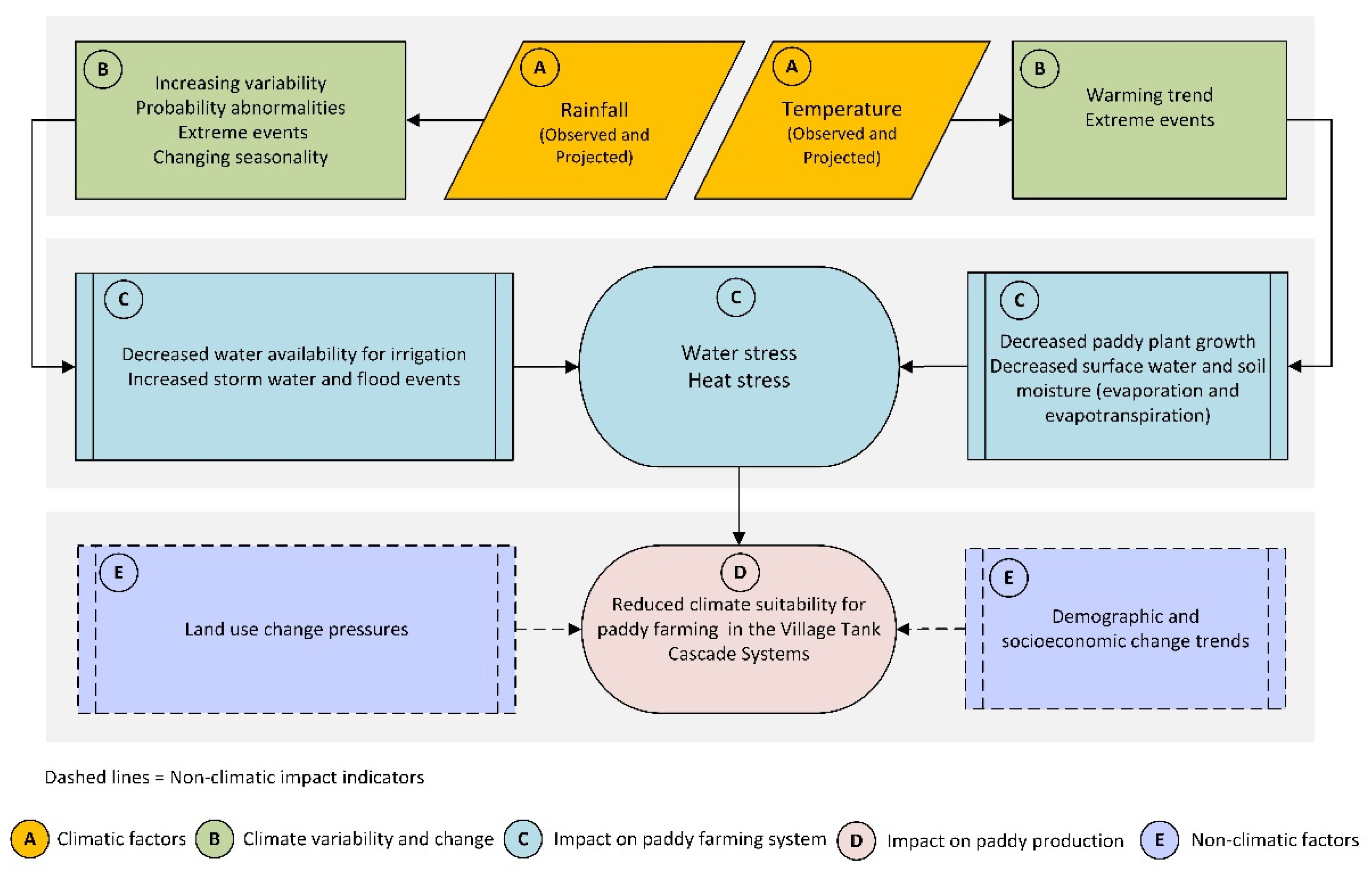

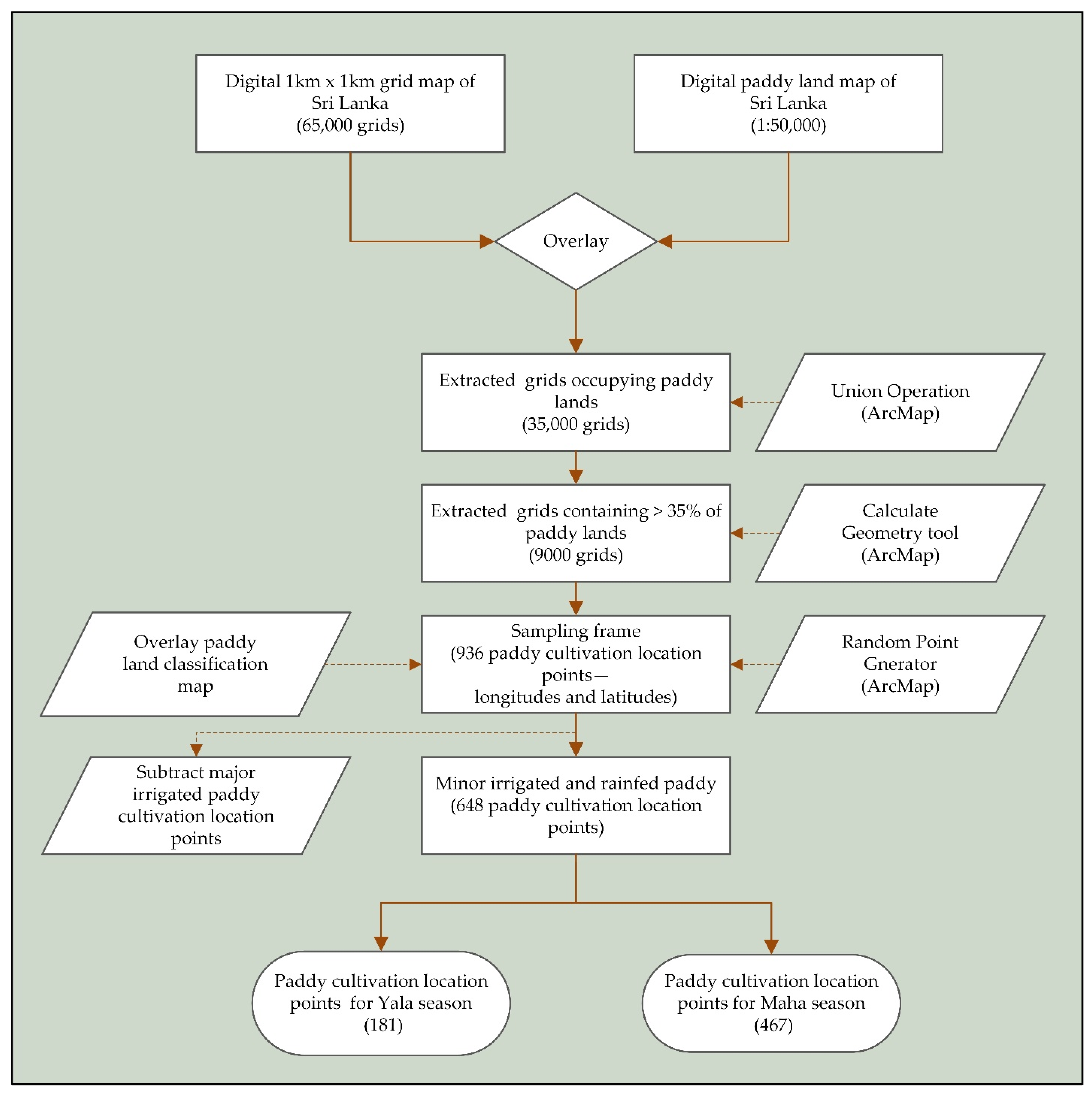

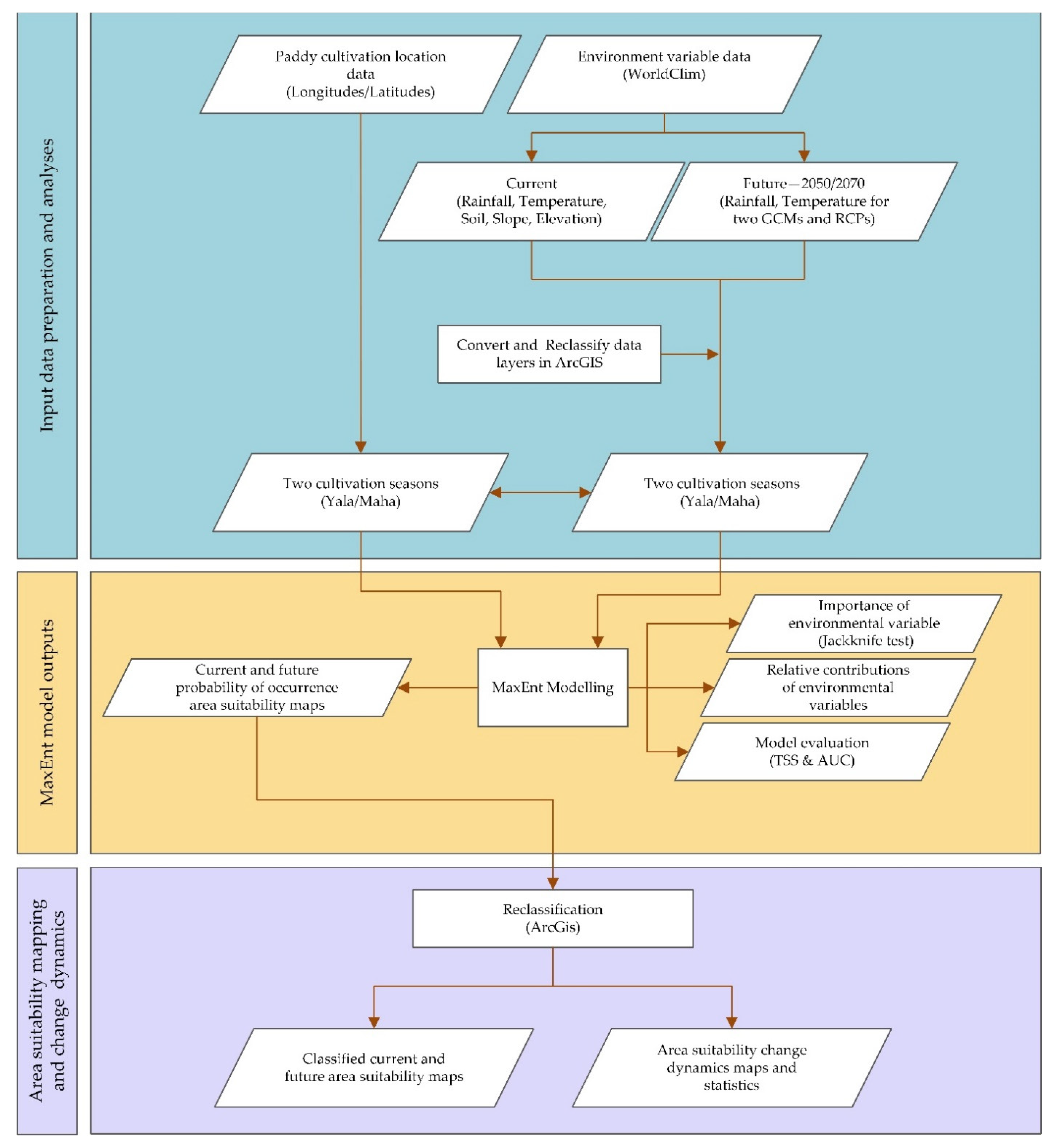
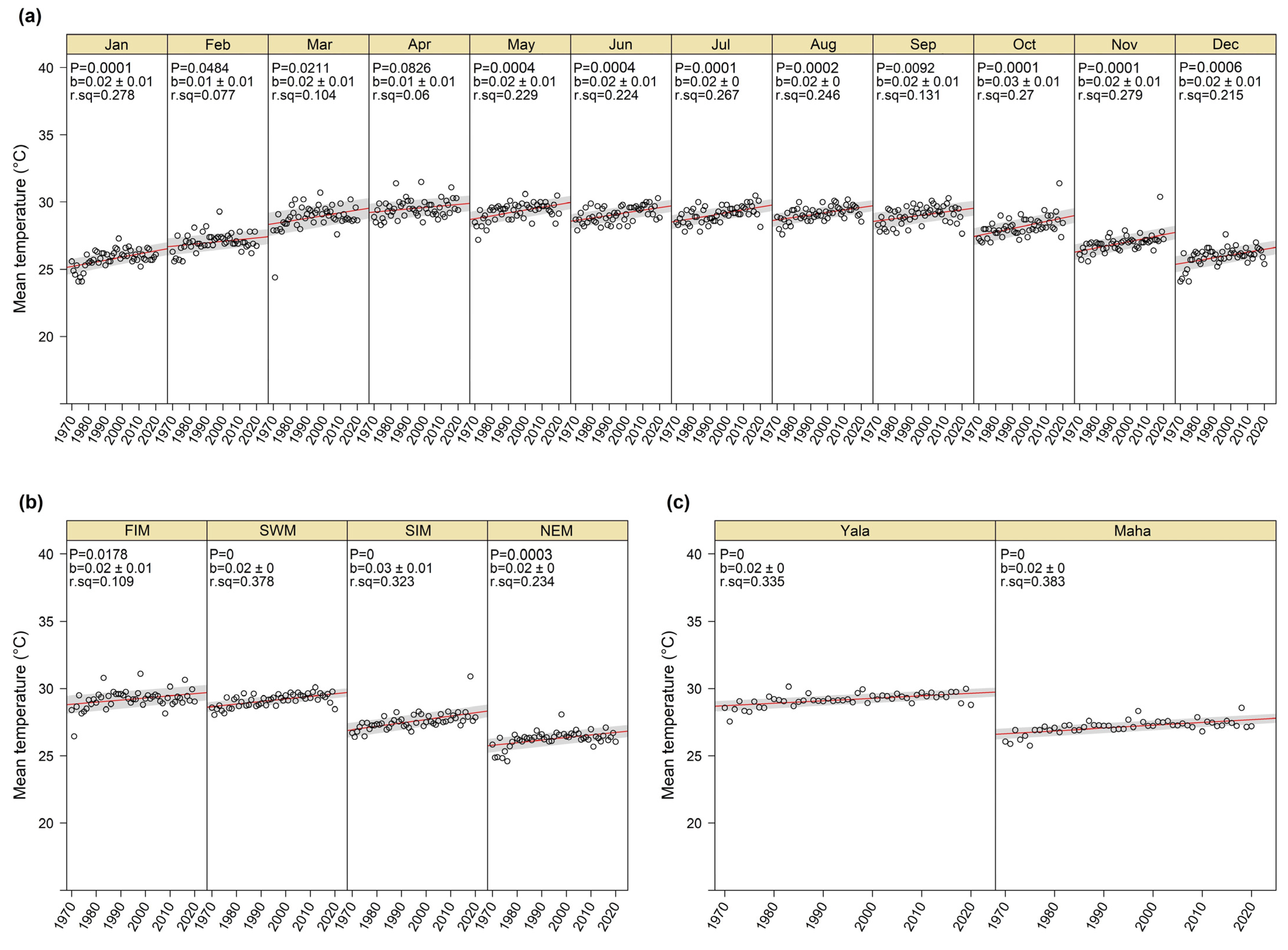

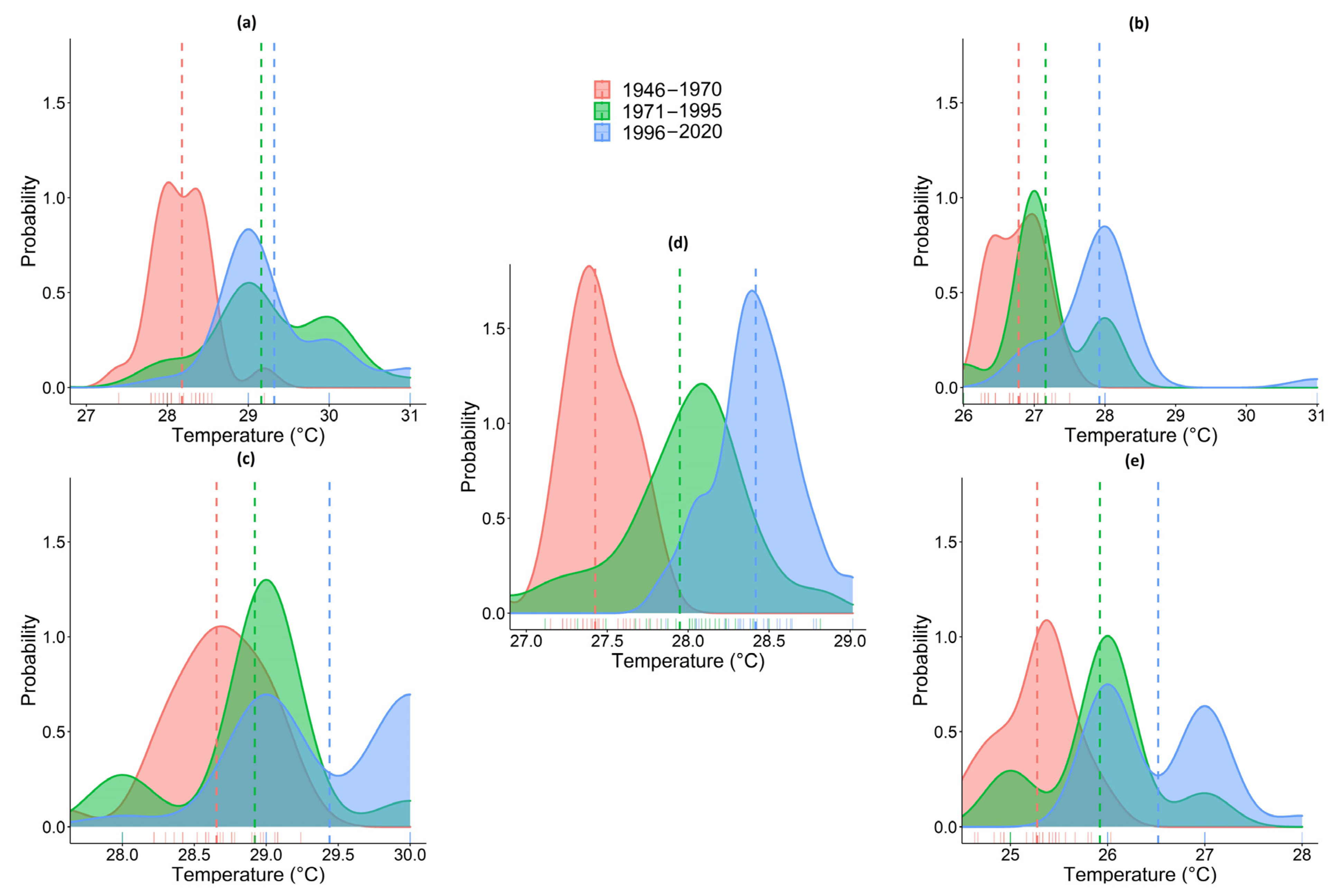

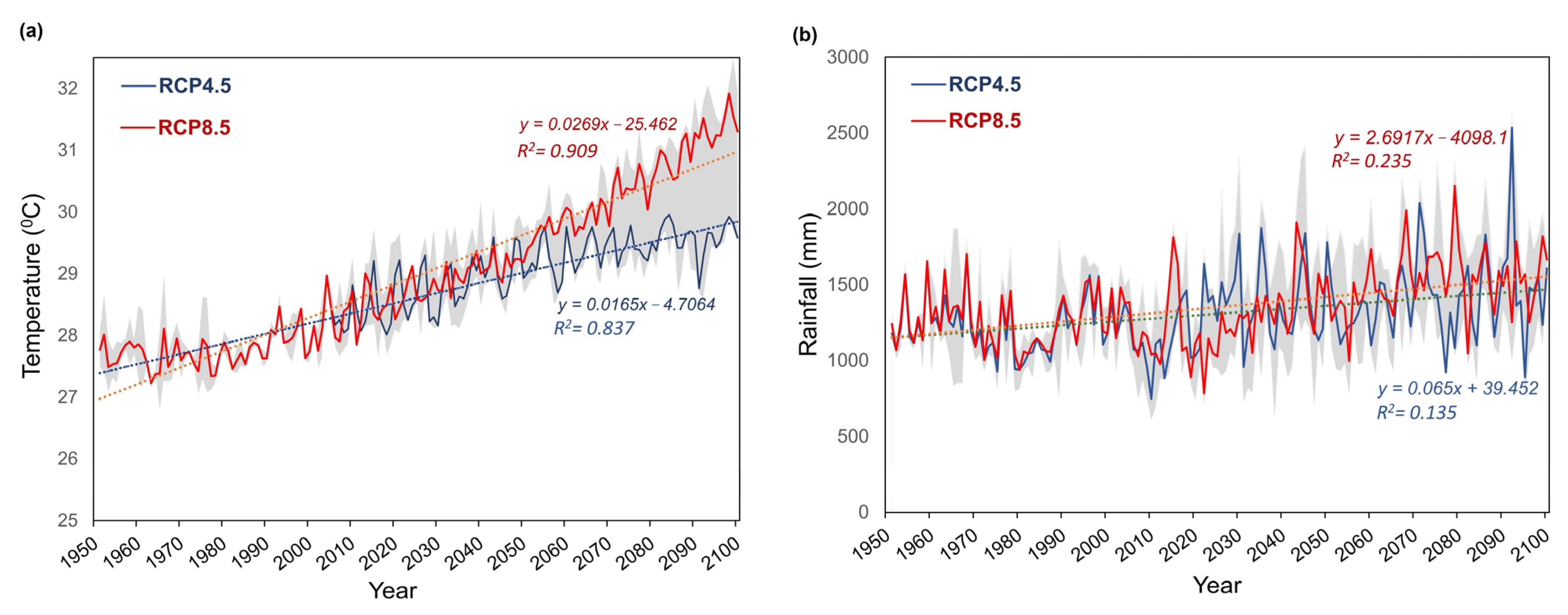
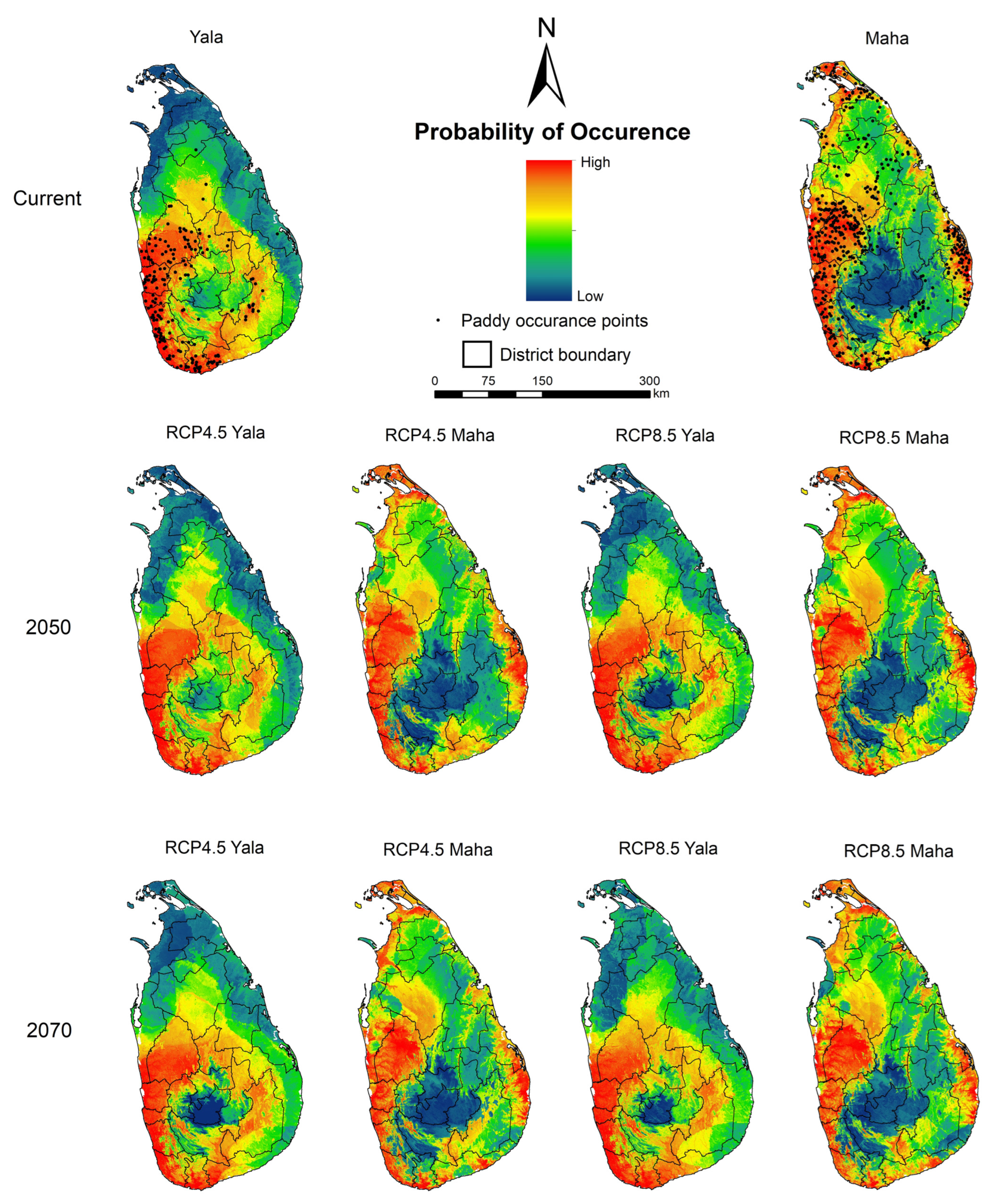
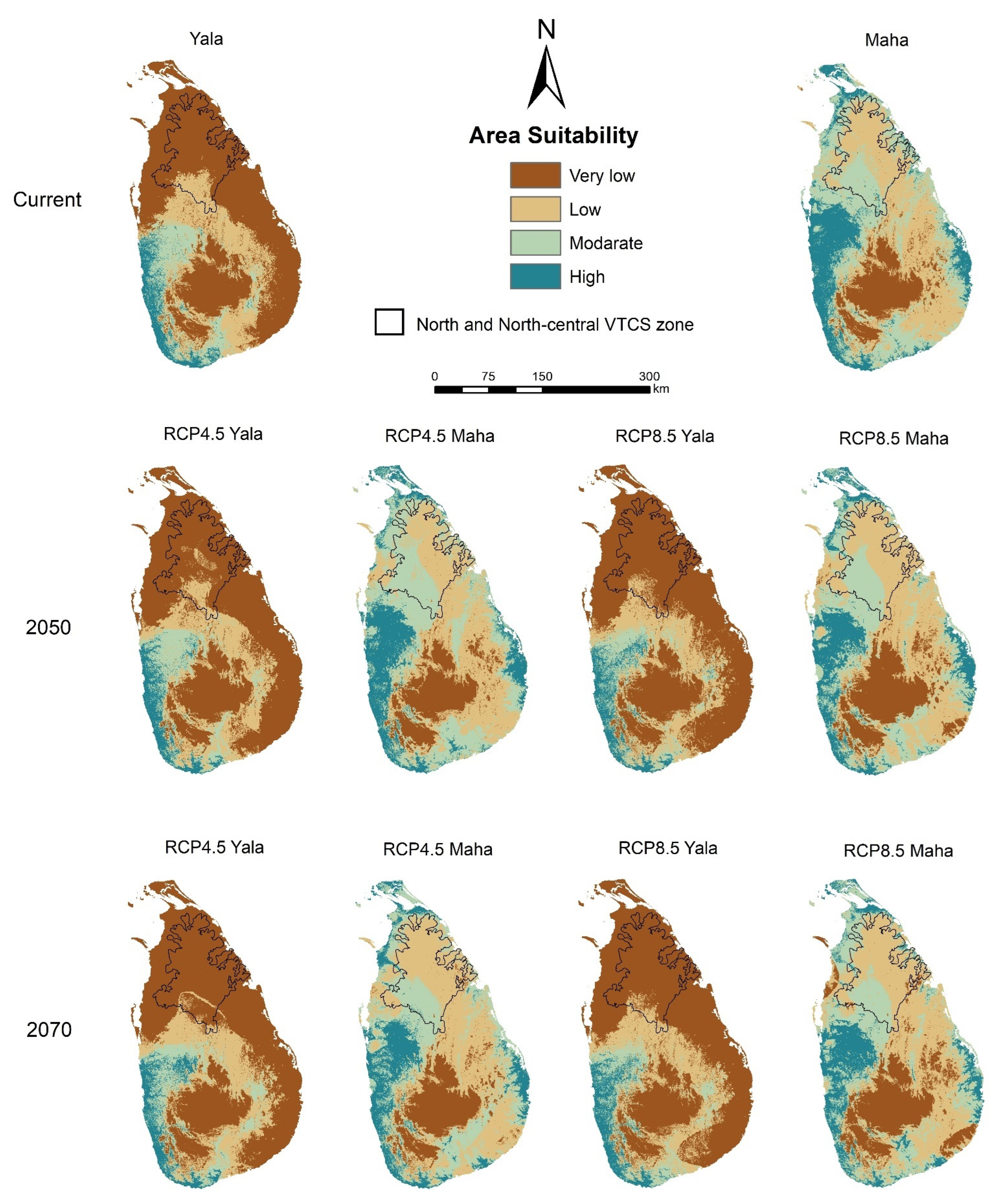
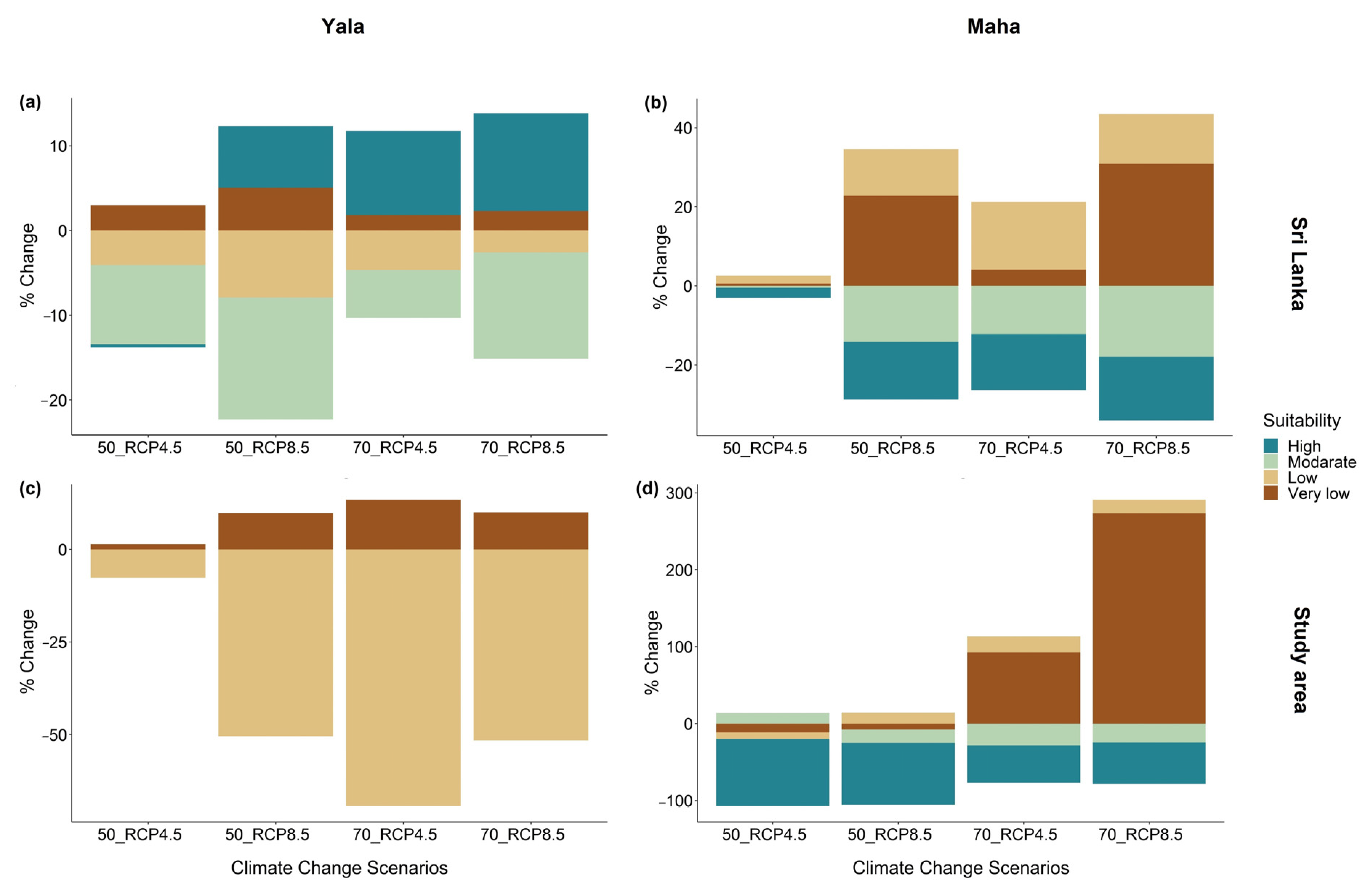
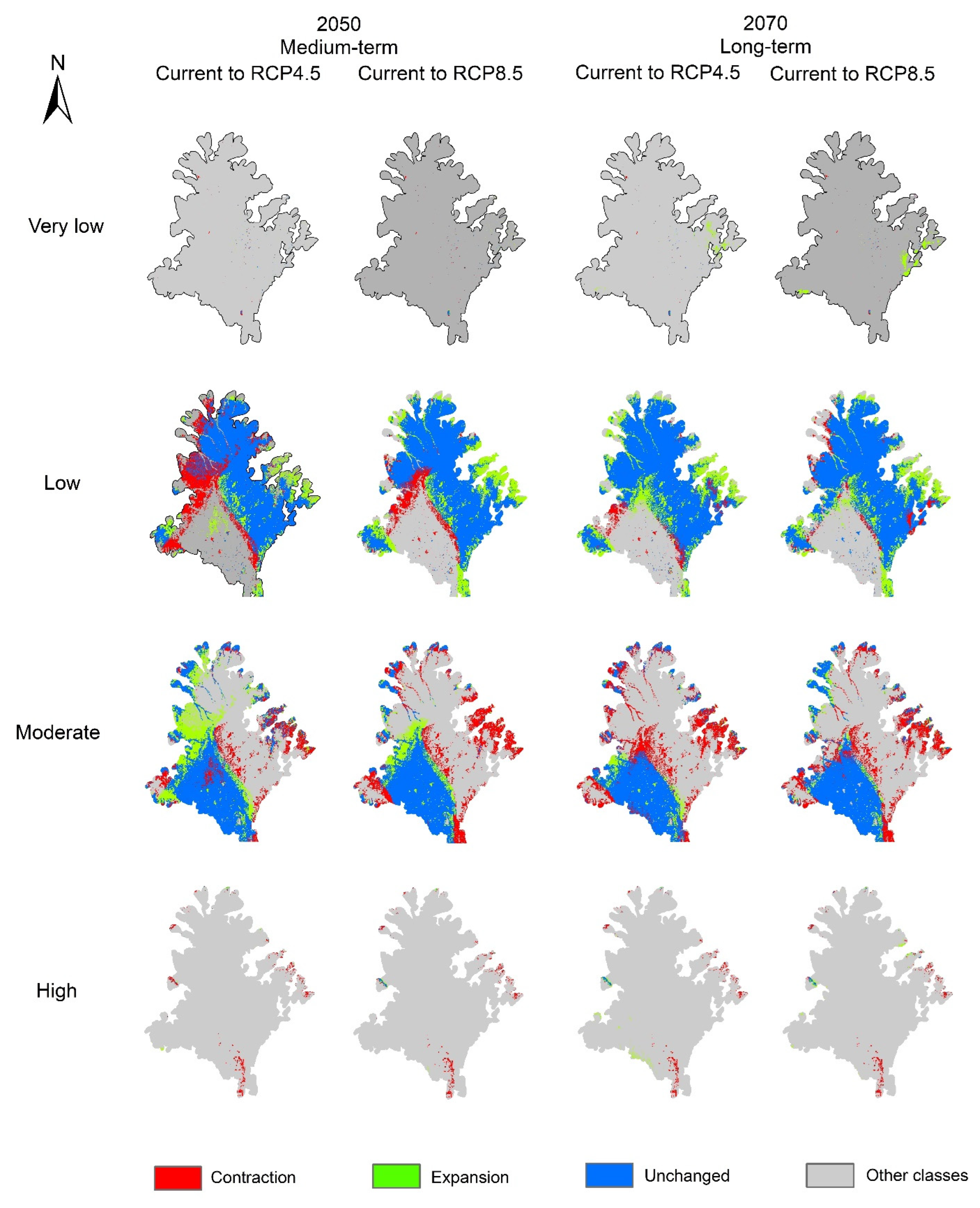

| Category | Source | Variable | Symbol | Climatic Season | Cultivation Season | Unit |
|---|---|---|---|---|---|---|
| Agro- climatological | WorldClim-Global Climate Data http://www.worldclim.org/ (accessed on 1 September 2021) | Rainfall/Temperature (March) | rf03/tm03 | FIM | Yala | mm/°C |
| Rainfall/Temperature (April) | rf04/tm04 | FIM | mm/°C | |||
| Rainfall/Temperature (May) | rf05/tm05 | SWM | mm/°C | |||
| Rainfall/Temperature (June) | rf06/tm06 | SWM | mm/°C | |||
| Rainfall/Temperature (July) | rf07/tm07 | SWM | mm/°C | |||
| Rainfall/Temperature (August) | rf08/tm08 | SWM | mm/°C | |||
| Rainfall/Temperature (September) | rf09/tm09 | SWM | Maha | mm/°C | ||
| Rainfall/Temperature (October) | rf10/tm10 | SIM | mm/°C | |||
| Rainfall/Temperature (November) | rf11/tm11 | SIM | mm/°C | |||
| Rainfall/Temperature (December) | rf12/tm12 | NEM | mm/°C | |||
| Rainfall/Temperature (January) | rf01/tm01 | NEM | mm/°C | |||
| Rainfall/Temperature (February) | rf02/tm02 | NEM | mm/°C | |||
| Agroecological | NRMC, Sri Lanka | Slope (Inclination angle) | slope | - | - | Degrees |
| Soil | soil | - | - | N/A | ||
| Elevation | dem | - | - | m |
| Time Series Climate Data | Kendall’s Tau | p-Value | Sen’s Slope |
|---|---|---|---|
| Mean annual temperature—RCP4.5 | 0.7307710 | 0.00 | 0.02 °C/year |
| Mean annual temperature—RCP8.5 | 0.8370324 | 0.00 | 0.03 °C/year |
| Mean annual rainfall—RCP4.5 | 0.2560179 | 0.00 | 2.06 mm/year |
| Mean annual rainfall—RCP8.5 | 0.3435347 | 0.00 | 2.90 mm/year |
| Accuracy Measure | Value |
|---|---|
| AUC | 0.763 |
| TSS | 0.441 |
| Sensitivity | 0.832 |
| Specificity | 0.609 |
| Suitability | Area of Interest | Area (km2) under Current Climate | 2050 (Medium-Term) | 2070 (Long-Term) | |||||||
|---|---|---|---|---|---|---|---|---|---|---|---|
| Area (km2) under RCP4.5 | Area (km2) under RCP8.5 | Area (km2) under RCP4.5 | Area (km2) under RCP8.5 | ||||||||
| Yala | Maha | Yala (%) | Maha (%) | Yala (%) | Maha (%) | Yala (%) | Maha (%) | Yala (%) | Maha (%) | ||
| High | Sri Lanka | 3696 | 11,320 | 3682 (−0.38%) | 11,033 (−2.54%) | 3965 (+7.28%) | 9665 (−14.62%) | 4062 (+9.90%) | 9718 (−14.15%) | 4122 (+11.53%) | 9502 (−16.06%) |
| Study area | 0 | 139 | 0 (0.00%) | 16 (−88.49%) | 0 (0.00%) | 25 (−82.01%) | 0 (0.00%) | 67 (−51.80%) | 0 (0.00%) | 60 (−56.83%) | |
| Moderate | Sri Lanka | 7046 | 20,957 | 6385 (−9.38%) | 20,855 (−0.49%) | 6031 (−14.41%) | 17,992 (−14.15%) | 6646 (−5.68%) | 18,403 (−12.19%) | 6160 (−12.57%) | 17,201 (−17.92%) |
| Study area | 0 | 4333 | 0 (0.00%) | 4865 (+12.28%) | 0 (0.00%) | 3532 (−18.49%) | 0 (0.00%) | 3055 (−29.49%) | 0 (0.00%) | 3220 (−25.69%) | |
| Low | Sri Lanka | 14,691 | 22,772 | 14,096 (−4.05%) | 23,225 (+1.99%) | 13,532 (−7.89%) | 25,448 (+11.75%) | 14,010 (−4.64%) | 26,664 (+17.09%) | 14,316 (−2.55%) | 25,643 (+12.61%) |
| Study area | 1665 | 5816 | 1537 (−7.69%) | 5412 (−6.95%) | 824 (−50.51%) | 6735 (15.80%) | 511 (−69.31%) | 7105 (+22.73%) | 807 (−51.53%) | 6889 (+19.31%) | |
| Very low | Sri Lanka | 39,061 | 9334 | 40,226 (+2.98%) | 9388 (+0.58%) | 41,038 (+5.06%) | 11,463 (+22.81%) | 39,788 (+1.86%) | 9721 (+4.15%) | 39,966 (+2.32%) | 12,215 (+30.87%) |
| Study area | 8649 | 26 | 8773 (+1.43%) | 23 (−11.54%) | 9491 (+9.74%) | 24 (−7.69%) | 9804 (+13.35%) | 88 (+92.31%) | 9509 (+9.94%) | 147 (+273.08%) | |
| Suitability | Change Category | 2050 (Medium-Term) | 2070 (Long-Term) | ||
|---|---|---|---|---|---|
| Area (km2) under RCP4.5 | Area (km2) under RCP8.5 | Area (km2) under RCP4.5 | Area (km2) under RCP8.5 | ||
| Very low | Contraction | 12 (46.15%) | 12 (46.15%) | 9 (34.62%) | 12 (46.15%) |
| Expansion | 9 (34.62%) | 10 (38.46%) | 72 (276.92%) | 133 (511.54%) | |
| Constant | 14 (53.85%) | 14 (53.85%) | 16 (61.54%) | 14(53.85%) | |
| Low | Contraction | 1399 (24.05%) | 632 (10.87%) | 343 (5.90%) | 373 (6.41%) |
| Expansion | 994 (17.09%) | 1550 (26.65%) | 1632 (28.06%) | 1446 (24.86%) | |
| Constant | 4418 (75.96%) | 5185 (89.15%) | 5473 (94.10%) | 5443 (93.59%) | |
| Moderate | Contraction | 965 (22.27%) | 1506 (34.76%) | 1658 (38.26%) | 1476 (34.06%) |
| Expansion | 1518 (34.55%) | 705 (16.27%) | 380 (8.77%) | 363 (8.38%) | |
| Constant | 3368 (77.73%) | 2827 (65.24%) | 2675 (61.74%) | 2857 (65.94%) | |
| High | Contraction | 133 (95.68%) | 125 (89.93%) | 123 (88.49%) | 118 (84.89%) |
| Expansion | 10 (7.19%) | 12 (8.63%) | 51 (36.69%) | 39 (28.06%) | |
| Constant | 6 (4.32%) | 13 (9.35%) | 16 (11.51%) | 21 (15.11%) | |
Disclaimer/Publisher’s Note: The statements, opinions and data contained in all publications are solely those of the individual author(s) and contributor(s) and not of MDPI and/or the editor(s). MDPI and/or the editor(s) disclaim responsibility for any injury to people or property resulting from any ideas, methods, instructions or products referred to in the content. |
© 2023 by the authors. Licensee MDPI, Basel, Switzerland. This article is an open access article distributed under the terms and conditions of the Creative Commons Attribution (CC BY) license (https://creativecommons.org/licenses/by/4.0/).
Share and Cite
Ratnayake, S.S.; Reid, M.; Larder, N.; Kadupitiya, H.K.; Hunter, D.; Dharmasena, P.B.; Kumar, L.; Kogo, B.; Herath, K.; Kariyawasam, C.S. Impact of Climate Change on Paddy Farming in the Village Tank Cascade Systems of Sri Lanka. Sustainability 2023, 15, 9271. https://doi.org/10.3390/su15129271
Ratnayake SS, Reid M, Larder N, Kadupitiya HK, Hunter D, Dharmasena PB, Kumar L, Kogo B, Herath K, Kariyawasam CS. Impact of Climate Change on Paddy Farming in the Village Tank Cascade Systems of Sri Lanka. Sustainability. 2023; 15(12):9271. https://doi.org/10.3390/su15129271
Chicago/Turabian StyleRatnayake, Sujith S., Michael Reid, Nicolette Larder, Harsha K. Kadupitiya, Danny Hunter, Punchi B. Dharmasena, Lalit Kumar, Benjamin Kogo, Keminda Herath, and Champika S. Kariyawasam. 2023. "Impact of Climate Change on Paddy Farming in the Village Tank Cascade Systems of Sri Lanka" Sustainability 15, no. 12: 9271. https://doi.org/10.3390/su15129271
APA StyleRatnayake, S. S., Reid, M., Larder, N., Kadupitiya, H. K., Hunter, D., Dharmasena, P. B., Kumar, L., Kogo, B., Herath, K., & Kariyawasam, C. S. (2023). Impact of Climate Change on Paddy Farming in the Village Tank Cascade Systems of Sri Lanka. Sustainability, 15(12), 9271. https://doi.org/10.3390/su15129271








